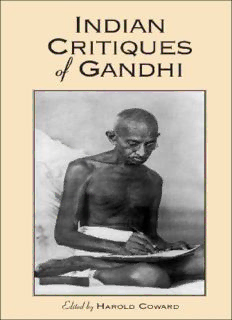
Indian critiques of Gandhi PDF
Preview Indian critiques of Gandhi
Indian Critiques of Gandhi SUNY series in Religious Studies Harold Coward, editor Indian Critiques of Gandhi Edited by Harold Coward State University of New York Press Published by State University of New York Press, Albany © 2003 State University of New York All rights reserved Printed in the United States of America No part of this book may be used or reproduced in any manner whatsoever without written permission. No part of this book may be stored in a retrieval system or transmitted in any form or by any means including electronic, electrostatic, magnetic tape, mechanical, photocopying, recording, or otherwise without the prior permission in writing of the publisher. For information, address State University of New York Press, 90 State Street, Suite 700, Albany, NY 12207 Production by Judith Block Marketing by Anne Valentine Library of Congress Cataloging-in-Publication Data Indian critiques of Gandhi/edited by Harold Coward. p. cm. — (SUNY series in Religious Studies) ISBN 0-7914-5909-8 (alk. paper) — ISBN 0-7914-5910-1 (pbk. : alk. paper) 1. Gandhi, Mahatma, 1869–1948—Political and social views. 2. India— History—Autonomy and independence movements. 3. India—Politics and Government—1919–1947. 4. Series. DS481.G3153 2003 954.03'5'092—dc22 2003059082 10 9 8 7 6 5 4 3 2 1 Contents Acknowledgments vii Harold Coward Introduction 1 Harold Coward Part I. Critiques of Gandhi by Individuals 1. The Convergence of Distinct Worlds: Nehru and Gandhi 19 Robert D. Baird 2. Gandhi, Ambedkar, and Untouchability 41 Harold Coward 3. Of Many Mahatmas: Besant, Gandhi, and Indian Nationalism 67 Joy Dixon 4. Sri Aurobindo’s Dismissal of Gandhi and His Nonviolence 87 Robert N. Minor 5. Tagore and Gandhi 107 T. S. Rukmani Part II. Critiques of Gandhi by Groups 6. The Hindu Mahasabha and Gandhi 131 Ronald Neufeldt 7. Gandhi and the Christian Community 153 Timothy Gorringe v vi CONTENTS 8. The Mahatma and the Sikhs 171 Nikky-Guninder Kaur Singh 9. Indian Muslim Critiques of Gandhi 193 Roland E. Miller 10. Gandhi and the Hindi-Urdu Question 217 Daud Rahbar Conclusion: A Debate for Our Times 239 Julius Lipner Appendix: Chronology of Gandhi, His Critics, and the Independence Movement 259 Hussein Keshani Contributors 271 Index 275 Acknowledgments This book could not have appeared without the financial support of the So- cial Sciences and Humanities Research Council of Canada. Thanks are also due to the President, Vice President Research, the Deans of Humanities and Social Science, the Centre for Global Studies and the Centre for Asia Pacific Initiatives of the University of Victoria—all of whom provided financial help. This book is a research project of the Centre for Studies in Religion and Society, University of Victoria, British Columbia, Canada. Special thanks are due to Moira Hill for arranging the meetings of the research team and to Connie Carter for preparing the manuscript for publication. vii Introduction HAROLDCOWARD Since his death in 1948 Gandhi’s life has been the subject of more than one thousand books and and Sir Richard Attenborough’s Oscar-winning film. Is another book needed? Surprisingly, an important aspect of Gandhi’s life that has not been given sustained study is his engagement of other major figures in the Indian Independence movement who were often his critics during the years 1920–1940. This book aims to fill that gap. We will examine the strengths and weaknesses of his contribution to India as evidenced in the let- ters, speeches, and newspaper articles focused on the dialogue/debate be- tween Gandhi and his major Indian critics. We have included within the term Indian not only obvious Indian colleagues who critically engaged Gandhi (e.g., Nehru, Tagore, and Ambedkar) but also two voices of British ancestry, Annie Besant and C. F. Andrews. Both had left England, made India their homeland, and debated with Gandhi the best course to take in achieving in- dependence for India. Indeed it was the Home Rule movement of Besant that Gandhi had to displace in getting his Non-Cooperation, or Swaraj, movement adopted by the Indian National Congress at Calcutta in 1920.1 Through letters, Andrews gave Gandhi critical counsel as an intimate friend throughout the 1920–1948 period. Included in our study are those who we felt were important leaders or groups within India from the perspective of Gandhi’s focus on the achievement of Independence. While his power base was rural village India (and those alienated from their ancestral villages), Gandhi also sought to incorporate minority groups such as the Muslims, Sikhs, and Untouchables within his Non-Cooperation movement. Thus we have featured groups as well as individuals in our analysis. Due to limitations of space and time, however, not everyone who critically engaged Gandhi has been included. Among those deserving of discussion, but whom we were un- able to include, are individuals such as Subhas Bose and groups such as the Indian Marxists. They are deserving of separate treatments elsewhere. 1
Description: